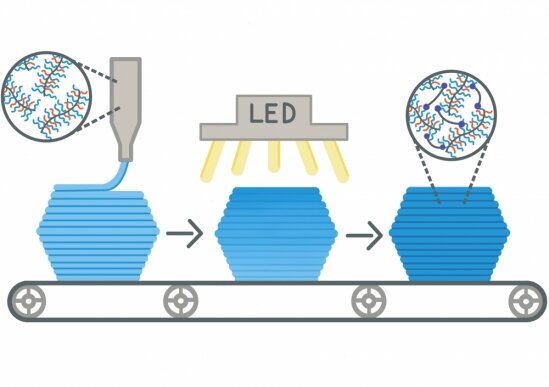A team working out of University of California at Santa Barbara has found a way to 3D print with so-called “bottlebrush” elastomers, or molecules with long “backbones” of polymers with linking polymers hanging off them. This discovery is particularly useful because the material has a novel texture: soft and elastic, much like human tissue.
Elastomers are a general name for stretchy polymers like rubber. Currently, we can print with linear elastomers, or stiffer materials made up of long, straight chains of molecules. But bottlebrush polymers are another story. So-named because they have little polymer “bristles” hanging off the linear “brush” of the main polymer, bottlebrush polymers feature a structure that allows them link together to form softer materials.
Right now, bottlebrush polymers can only be produced by more time-consuming simple molding procedures. A study published earlier this month in Science Advances might change that, however. Postdoctoral researcher Sanjoy Mukherjee discovered a new polymer by accident: a semi-soft solid that holds its shape, but will go liquid at room temperature in response to pressure (otherwise known as a yield stress fluid). This reaction is reversible, meaning that it can be liquified to pass through a syringe, and then become solid again on the other side. This property comes from the bottlebrush polymers “self-assembling” into a solid with bonds weak enough that they’ll yield under pressure.
The property means it can be printed via Direct Ink Writing: passing low-viscosity ink through a nozzle or syringe to solidify after it prints. The team, headed by Mukherjee and colleague Renxuan Xie, printed the material using a modified LulzBot TAZ Workhorse. After printing, the team bathed their test items in UV light to cure them. This was possible because of a photocrosslinker added to the polymer, which connected nearby polymers to make the printed product permanently solid.

The bottlebrush polymer can be “cured” by UV light after printing, making it permanently solid (Image via Isabelle Chabinyc/Science Advances).
The bottlebrush polymer has very unique properties.
“The modulus of our material is a thousand times smaller than that of a rubber band,” said Xie. “It is super-soft—it feels very much like human tissue—and very stretchy. It can stretch about three to four times its length.”
Just as remarkably, the material is soft and stretchy without the need for water or solvents.
“People often add solvent to liquify a solid so that it can be squeezed out of a nozzle,” Xie added, “but if you add solvent, it has to evaporate after printing, causing the object to change its shape or crack.”
The new polymer has the potential to be very useful, especially in printing biomimetic tissue or touch-sensitive electronics. The team is particularly excited about the potential for using it in medical applications. Their paper points out that the end groups on the polymers are benzophenones, which are generally well-tolerated by the body. And the material’s texture may help.
“These super-soft elastomers might be applicable as implants,” said Christopher Bates, an assistant professor of materials, and the head of one of the labs where the research was conducted. “You may be able to reduce inflammation and rejection by the body if the mechanical properties of an implant match native tissue.”
Subscribe to Our Email Newsletter
Stay up-to-date on all the latest news from the 3D printing industry and receive information and offers from third party vendors.
Print Services
Upload your 3D Models and get them printed quickly and efficiently.
You May Also Like
Johns Hopkins University Researchers Develop HyFAM Technology
Two scientists from Johns Hopkins University, Nathan C. Brown and Jochen Mueller, have developed a hybrid manufacturing technology they call HyFam, or Hybrid Formative Additive Manufacturing. Their work on this technology...
3D Printing G-Code Gets an Upgrade: T-Code
Good old G-Code still manages many 3D printers, great and small. Just like the STL, it’s a standard that enables collaboration while also holding the additive manufacturing (AM) industry back....
AM Rewind: The Biggest News and Trends of 2024
After a sluggish 2023, driven by persistent inflation and geopolitical tensions, 2024 has seen some recovery. Economic growth climbed from about 2.8 percent in 2023 to a modest 3.2 percent...
Metal Wire 3D Printer OEM ValCUN Announces Plans for 2025 Expansion
ValCUN, a Belgian original equipment manufacturer (OEM) of wire-based metal additive manufacturing (AM) hardware, has announced that the company has entered the next phase of its growth trajectory, making key...

































